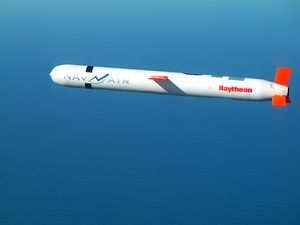Plans under the Trump administration for a new nuclear-capable sea-launched cruise missile are alive and well. The capability, called for by the Trump administration’s 2018 Nuclear Posture Review, is slated to enter initial development, even as much about the precise system remains unclear and the introduction of the capability itself remains years away.
According to Defense News last week, the U.S. Department of Defense intends “to create a program of record for a new nuclear-armed, submarine-launched cruise missile in its next budget request, with the goal of deploying the weapon in 7-10 years.” The Diplomat’s Robert Farley took a look at some of the problems that a new sea-launched cruise missile presents—for strategic stability and operations generally.
It’s unclear to me why exactly the administration is pushing ahead with the sea-launched cruise missile when one of the most prominent stated rationales in the Nuclear Posture Review no longer applies. In the original document, the Trump administration underscored the role for this new system as potentially playing a role in creating incentives for Russia to come back to the table on addressing its alleged violation of the 1987 Intermediate-Range Nuclear Forces Treaty.
Neither the United States no Russia is a participant in that treaty, which barred an entire class of ground-launched missiles in the 500 to 5,500 km range category, as of last year. After more than five years of accusations that Russia was noncompliant with the treaty after developing and deploying a cruise missile known as the 9M729, the Trump administration articulated its intent to withdraw from the treaty in February 2019 and U.S. withdrawal was effectuated in August 2019.
“SLCM will provide a needed non-strategic regional presence, an assured response capability, and an INF-Treaty compliant response to Russia’s continuing Treaty violation,” the Trump administration’s Nuclear Posture Review noted.
“If Russia returns to compliance with its arms control obligations, reduces its non-strategic nuclear arsenal, and corrects its other destabilizing behaviors, the United States may reconsider the pursuit of a SLCM,” the document added, making explicit the notion of using this system as leverage to be traded in arms control negotiations with Russia.
The Nuclear Posture Review goes further than just INF, noting that “U.S. pursuit of a SLCM may provide the necessary incentive for Russia to negotiate seriously a reduction of its non-strategic nuclear weapons, just as the prior Western deployment of intermediate-range nuclearforces in Europe led to the 1987 INF Treaty.”
Even as the SLCM remains years out, it may rear its head should the Trump administration enter into serious negotiations to extend the 2011 Strategic Arms Reduction (or New START) treaty, which expires in less than a year. The treaty applies to Russian and U.S. strategic offensive arms and critics—including in the Trump administration—have expressed interest in addressing Russia’s nonstrategic nuclear arsenal as part of extension talks.
Still, as Farley discusses, given the problems that appear to arise from the development and deployment of a new SLCM and the limited role of such a system in arms control after the demise of the arms control treaty, the Trump administration’s determination to push ahead with this system appears particularly ill-advised.
One reason may be an impulse to expand U.S. lower-yield nuclear use options in the Indo-Pacific, where concerns persist about China, but the Trump administration has not made this case explicitly. In any case, the nuclear SLCM would exist alongside the already-fielded W76-2 lower-yield nuclear warhead for the U.S. Trident D5 submarine-launched ballistic missile—another capability called for by the 2018 Nuclear Posture Review.
Given the long development timeline associated with the SLCM, it is possible that a new U.S. administration may call off the weapon’s development. The U.S. has not possessed a nuclear-capable, sea-launched cruise missile capability since the Obama administration retired the nuclear Tomahawk land-attack missile (TLAM-N) starting in 2010.

































